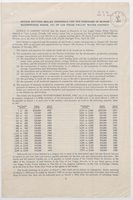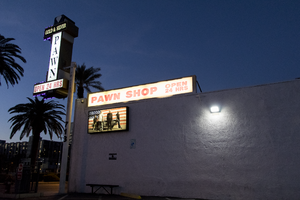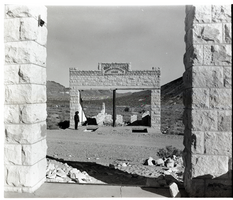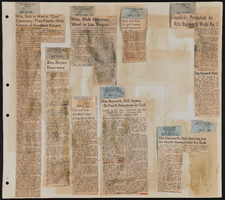Search the Special Collections and Archives Portal
Search Results

Meeting minutes for Consolidated Student Senate University of Nevada, Las Vegas, November 4, 1992
Date
Archival Collection
Description
Text

Notice inviting sealed proposals for the purchase of $8,700,000 waterworks bonds of Las Vegas Valley Water District, April 5, 1954
Date
Archival Collection
Description
Prospectus for the Las Vegas Valley Water District's $8.7 million bond issue. This notice is given pursuant to the Las Vegas Valley Water District Board of Directors resolution adopted April 2, 1954. Date stamp from E. E. Bennett
Text
Michael Brown (Governor's Office of Economic Development) conducted by Kelliann Beavers: transcript
Date
Archival Collection
Description
From the Lincy Institute "Perspectives from the COVID-19 Pandemic" Oral History Project (MS-01178) -- Government agency interviews file.
Text

Sara Kalaoram oral history interview: transcript
Date
Archival Collection
Description
Oral history interview with Sara Kalaoram conducted by Alexandra Arabshian on November 15, 2021 for Reflections: The Las Vegas Asian American and Pacific Islander Oral History Project. Sara Kalaoram shares her immigration story to the United States from Singapore in 2002 at the age of four. She talks about her upbringing in Las Vegas, Nevada, her education from Arizona State University, and her work with the Culinary Workers Union and with Assemblyman Steve Yeager as his campaign manager and executive assistant. Sara Kalaoram discusses cultural differences between Singapore and the United States, the immigration stories of her parents, and her experience as an Asian-American immigrant in the twenty-first century.
Text

Interview with John Frederick Campbell, January 31, 2006
Date
Archival Collection
Description
Text

Photographs of Gold and Silver Pawn Shop signs, Las Vegas (Nev.), March 3, 2017
Date
Archival Collection
Description
Site address: 713 S Las Vegas Blvd
Sign owner: Richard Harrison
Sign details: This pawn shop was opened by Richard Harrison in 1988. Rick , Richard and Corey Harrison along with Austin Russell made this store famous with the History Channel reality T.V. show Pawn Stars which started airing in 2009. This show has made this location a tourist destination, so much so there is even a line to get in sometimes. With the rise of popularity they added Rick Harrison's Pawn Plaza which is a shopping center with eateries.
Sign condition: 4- looks relatively new and not too faded
Sign form: Rectangular Blade
Sign-specific description: The whole blade sign is outlined with a gold trim and red LED lights surrounding the gold. The main long rectangle blade spells out "PAWN" lengthwise in black on white backdrop. Right above the white part of the blade is a black rectangle (long side of rectangle is above the white blade) stating "Gold & Silver" written in white thin printed letters. Above this is a little white diamond. Below the white PAWN blade is a white rectangle stating "OPEN 24 HRS" in red block print letters. This blade-type sign is held right next to the building on a big white beam that has their address "713" painted on it. On the building above the entrance states "World Famous (in yellow) Gold and Silver (In red) Pawn Shop ( in Green) in back lit plastic letters. Also to the left of the entrance they have 3 plastic rectangle back lit signs that they have switched out over the years, but the current ones have been up since 2011/12. The one in the middle states "World Famous Gold & Silver Pawn Shop" in an elaborate white cursive font written on a black background. The other two showcase the Welcome to Fabulous Las Vegas Logo but states "World Famous Gold & Silver Las Vegas" . Below these three rectangle signs there is another smaller one with a white background stating "We Never Close" in thick blue type font letters.
Sign - type of display: Back lit plastic signs, LED lights
Sign - media: Steel, Plastic
Sign - non-neon treatments: Back lit plastic
Sign animation: Charger with red LED's
Sign environment: Halfway between the strip and downtown on Las Vegas Blvd. There are a few antique shops near the pawn shop. Right next door is now Rick Harrison's Pawn Plaza Shopping Center as well as a nice sized parking lot to accommodate their guests.
Sign - date of installation: Has been up since at least 2007
Sign - date of redesign/move: Some of the plastic back lit signs have been switched out over the years
Sign - thematic influences: Gold+ Silver- could refer to the mining times in Nevada and since it is a pawn shop it could mean that you can strike it rich with bringing something there. Similar to finding gold or silver.
Sign - artistic significance: The blade type sign was popular in the 50's for directions in the car consumer and traveling era.
Survey - research locations: Acessor's page, Nevada Magazine http://nevadamagazine.com/home/inside-the-magazine/city-limits/gold-silver-pawn-shop/ , Gold and Silver Pawn Shop website https://gspawn.com/ , history.com for information on the show
Surveyor: Emily Fellmer
Survey - date completed: 2017-08-12
Sign keywords: Backlit; Plastic; LED; Steel; Pole sign
Mixed Content

Film transparency of the ruins of the H. D. and L. D. Porter Brothers Store, Rhyolite, Nevada, November 25, 1948
Date
Archival Collection
Description
Image


